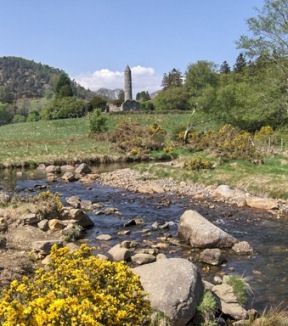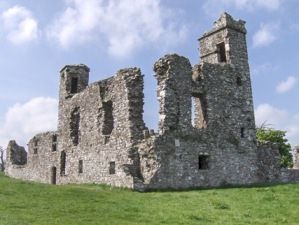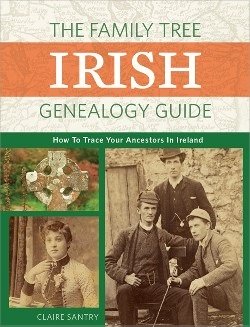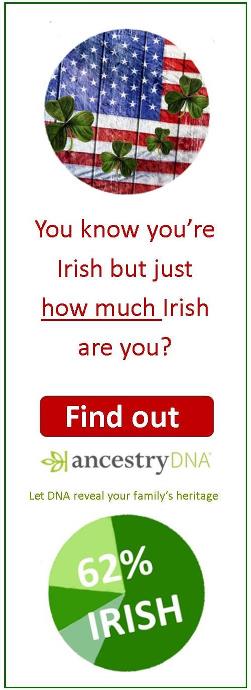- Home ›
- Genetic Genealogy ›
- Niall of the 9 hostages
Niall of the Nine Hostages
Niall of the Nine Hostages leapt from the legends of Ireland straight into the modern world when scientists at Trinity College Dublin revealed that as many as three million men living today may carry his y-DNA signature.
 Distant view of Round Tower at Glendalough
Distant view of Round Tower at Glendalough Distant view of Round Tower at Glendalough
Distant view of Round Tower at GlendaloughIn the absence of a DNA sample direct from the man himself, Trinity's team of geneticists collected a number of samples from men across Ireland. Their findings led them to the notion that Niall of the Nine Hostages may be the Big Daddy of Ireland:
- A significant proportion of men who can trace their ancestry to Ireland, and especially the north of Ireland, carry a specific Y-DNA pattern called the M222 sub-clade.
- The signature is especially prevalent in the genes of men with surnames that have long been linked to Niall and his dynasty.
- Geneticists have dated this M222 signature to the mid-5th century when Niall of the Nine Hostages may have been High King of Ireland.
- Because the numbers of men with this signature is so high, the patriarch must have been prolific. Such a level of promiscuity and a resulting high number of offspring would have been accepted, even expected, in Celtic circles from an important king.
The
historical reality of Niall of the Nine Hostages wasn't proved before the
Trinity College study, nor do the researchers conclude that he ever existed.
Surnames
Some of the modern surnames associated with the Ui Neill include (with or without the O prefix):
Neill, Boyle, Bradley, Campbell, Cannon, Coleman, Connor, Devlin, Doherty, Donnell, Donnelly, Egan, Flynn, Gallagher, Gormley, Hynes, Kane, McGovern, McLoughlin, McManus, Molloy, Reilly, Rourke and Quinn.
Surnames
Some of the modern surnames associated with the Ui Neill include (with or without the O prefix):
Neill, Boyle, Bradley, Campbell, Cannon, Coleman, Connor, Devlin, Doherty, Donnell, Donnelly, Egan, Flynn, Gallagher, Gormley, Hynes, Kane, McGovern, McLoughlin, McManus, Molloy, Reilly, Rourke and Quinn.
However, the genetic evidence of the study does seem to show that the strongest associations are with the surnames traditionally linked to the Ui Neill ie Doherty, Gallagher, O'Reilly, Quinn (see Surnames box).
These names continue to be most prevalent in the Northwest of Ireland, the historical stronghold of the Ui Neill, where the study found the genetic fingerprint of Niall of the Nine Hostages in the y-DNA of one in five men (21%). The M222 pattern is a lot rarer in the south of the island.
Across the island as a whole, a different sub-clade the M269 pattern is predominant, while the M222 pattern is found in 8.2% or one man in twelve.
The Trinity College study also found that about one in ten men in the west or central areas of Scotland have the so-called Niall of the Nine Hostages gene.
So, too, do about 1-in-50 New Yorkers of European heritage, reflecting three centuries of Irish emigration to North America.
The life and myth of Niall of the Nine Hostages
Niall of the Nine Hostages, (in Irish, Niall Naoi Noígiallach) is a quasi-historical character in Ireland's story. Myth has it that he was descended by an unknown number of generations from Conn Céadcathlach aka Conn of the Hundred Battles, who may have lived in the middle of the 2nd century and was reputedly the first high king of Ireland.
Y-DNA in brief
Y-DNA is passed from father to son.
Occasional mutations (changes) occur infrequently but, when they do, they help to distinguish one line of DNA from another. Over the generations, a genetic signature is created.
More about Y-DNA.
The Family Tree
Irish Genealogy Guide
Written by the creator of Irish Genealogy Toolkit and Irish Genealogy News, 'The Family Tree Irish Genealogy Guide' is full of advice, tips and strategies to ease what can be a challenging journey.
Its guidance will be useful to any researcher of Irish heritage, but especially for the target Irish-American researcher who's struggling to work back to Ireland from their immigrant ancestor.
Publisher Penguin Random House.
ISBN: 9781440348808 / 240 pages.
The O'Neill dynasty (Ui Néill means 'descended from Niall') is an historical certainty, even if its founder is not. According to legend, Niall was a warrior king at a time when Ireland was divided into many kingdoms and a heirarchy of kingship existed.
Just how extensive an area he may have dominated is not recorded but he fought his way to become King of Tara in the late 4th or early 5th century.
In time, the status of King of Tara came to denote High King of Ireland, the latter a misleading term that should not be construed as meaning the bearer had control of all the island.
Ruling from Tara, Niall's modus operandi for gaining dominance was taking hostages from the family of neighbours and under-kings.
He also led successful raids against Roman Britain & Scotland (some stories say that the future St Patrick was among hostages taken from one such expedition) and conquered much of Ulster.
Niall's legendary military skill was on a par with his sexual prowess. In modern parlance, he put it about.
This was expected of someone of his status in a polygamous society where all children, from wives or concubines, were acknowledged. Legend accords him at least 12 sons.
After the death of Niall of the Nine Hostages, one of his sons, Laedhaire, became High King. He and his descendants continued to dominate much of Ireland for most of the next six centuries.
 Slane Abbey: built on the hill where St Patrick is said to have lit the fire that convinced High King Laoghaire, Niall's son and successor, to agree to the preaching of Christianity.
Slane Abbey: built on the hill where St Patrick is said to have lit the fire that convinced High King Laoghaire, Niall's son and successor, to agree to the preaching of Christianity. Slane Abbey: built on the hill where St Patrick is said to have lit the fire that convinced High King Laoghaire, Niall's son and successor, to agree to the preaching of Christianity.
Slane Abbey: built on the hill where St Patrick is said to have lit the fire that convinced High King Laoghaire, Niall's son and successor, to agree to the preaching of Christianity.All but two of the High Kings of Tara came from this family.
By the 8th century, the Ui Néills held power in the north west where they were known as the Northern Ui Néill, and also in the Midlands where they are known as the Southern Ui Néill.
Genealogical pedigrees dating back to the 5th century, when Laedhaire's children and grandchildren were around, are considered accurate.
Who were the nine hostages?
There are two stories to identify Niall's nine hostages.
The less well-known story has it that they were taken from the Airgialla, a once powerful people who controlled an area loosely centred on present-day Armagh and Tyrone.
A second, and probably less reliable, story is that Niall took a hostage from each of Ireland's five ancient provinces (Connaught, Munster, Leinster, Ulster and Meath) and also captured a Briton, a Gaul, a Saxon and a Scot.
Y-DNA in brief
Y-DNA is passed from father to son. Women do not have Y-dna.
Occasional mutations (changes) occur infrequently but, when they do, they help to distinguish one line of DNA from another.
Over the generations, a genetic signature is created.
More about Y-DNA.
Who were the nine hostages?
There are
two stories to identify Niall's nine hostages.
The less well-known story has it that they were taken from the Airgialla, a once powerful people who controlled an area loosely centred on present-day Armagh and Tyrone.
A second, and probably less reliable, story is that Niall took a hostage from each of Ireland's five ancient provinces (Connaught, Munster, Leinster, Ulster and Meath) and also captured a Briton, a Gaul, a Saxon and a Scot.
The Family Tree Irish Genealogy Guide
Written by the creator of Irish Genealogy Toolkit and Irish Genealogy News, 'The Family Tree Irish Genealogy Guide' is full of advice, tips and strategies to ease what can be a challenging journey.
Its guidance will be useful to any researcher of Irish heritage, but especially for the target Irish-American researcher who's struggling to work back to Ireland from their immigrant ancestor.
Publisher: Penguin
ISBN: 9781440348808 / 240 pages.


